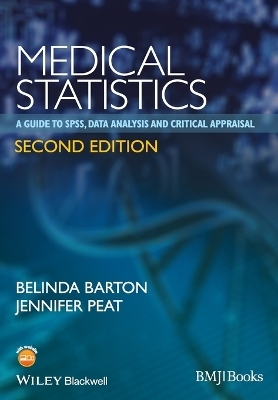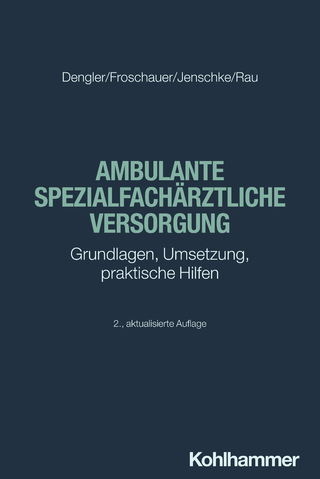
Medical Statistics
BMJ Books (Verlag)
978-1-118-58993-9 (ISBN)
- Lieferbar (Termin unbekannt)
- Versandkostenfrei innerhalb Deutschlands
- Auch auf Rechnung
- Verfügbarkeit in der Filiale vor Ort prüfen
- Artikel merken
Medical Statistics provides the necessary statistical tools to enable researchers to undertake and understand evidence-based clinical research.
It is a practical guide to conducting statistical research and interpreting statistics in the context of how the participants were recruited, how the study was designed, what types of variables were used, what effect size was found, and what the P values mean. It guides researchers through the process of selecting the correct statistics and show how to best report results for presentation and publication.
Clear and concise explanations, combined with plenty of examples and tabulated explanations are based on the authors’ popular medical statistics courses.
The table of contents is divided into sections according to whether data are continuous or categorical in nature as this distinction is fundamental to selecting the correct statistics. Each chapter provides a clear step-by-step guide to each statistical test with practical instructions on how to generate and interpret the numbers, and present the results as scientific tables or graphs. The chapters conclude with critical appraisal guidelines to help researchers review the reporting of results from each type of statistical test.
This new edition includes a new chapter on repeated measures and mixed models and a helpful glossary of terms provides an easy reference that applies to all chapters.
Belinda Barton, Head and Psychologist, Children's Hospital Education Research Institute (CHERI), Conjoint Senior Lecturer, Sydney Medical School, University of Sydney, NSW Australia. Jennifer Peat, Associate Professor, Department of Paediatrics and Child Health and Senior Hospital Statistician, Clinical Epidemiology Unit, Children's Hospital, Westmead, NSW Australia.
Introduction, ix
Acknowledgements, xiii
About the companion website, xv
Chapter 1 Creating an SPSS data file and preparing to analyse the data, 1
1.1 Creating an SPSS data file, 1
1.2 Opening data from Excel in SPSS, 6
1.3 Categorical and continuous variables, 7
1.4 Classifying variables for analyses, 7
1.5 Hypothesis testing and P values, 8
1.6 Choosing the correct statistical test, 9
1.7 Sample size requirements, 10
1.8 Study handbook and data analysis plan, 12
1.9 Documentation, 13
1.10 Checking the data, 13
1.11 Avoiding and replacing missing values, 14
1.12 SPSS data management capabilities, 16
1.13 Managing SPSS output, 20
1.14 SPSS help commands, 21
1.15 Golden rules for reporting numbers, 21
1.16 Notes for critical appraisal, 21
References, 23
Chapter 2 Descriptive statistics, 24
2.1 Parametric and non-parametric statistics, 25
2.2 Normal distribution, 25
2.3 Skewed distributions, 26
2.4 Checking for normality, 29
2.5 Transforming skewed variables, 43
2.6 Data analysis pathway, 49
2.7 Reporting descriptive statistics, 49
2.8 Checking for normality in published results, 50
2.9 Notes for critical appraisal, 51
References, 51
Chapter 3 Comparing two independent samples, 52
3.1 Comparing the means of two independent samples, 52
3.2 One- and two-sided tests of significance, 54
3.3 Effect sizes, 55
3.4 Study design, 57
3.5 Influence of sample size, 58
3.6 Two-sample t-test, 71
3.7 Confidence intervals, 73
3.8 Reporting the results from two-sample t-tests, 75
3.9 Rank-based non-parametric tests, 80
3.10 Notes for critical appraisal, 88
References, 89
Chapter 4 Paired and one-sample t-tests, 90
4.1 Paired t-tests, 90
4.2 Non-parametric test for paired data, 97
4.3 Standardizing for differences in baseline measurements, 99
4.4 Single-sample t-test, 102
4.5 Testing for a between-group difference, 106
4.6 Notes for critical appraisal, 110
References, 111
Chapter 5 Analysis of variance, 112
5.1 Building ANOVA and ANCOVA models, 113
5.2 ANOVA models, 113
5.3 One-way analysis of variance, 117
5.4 Effect size for ANOVA, 127
5.5 Post-hoc tests for ANOVA, 128
5.6 Testing for a trend, 133
5.7 Reporting the results of a one-way ANOVA, 134
5.8 Factorial ANOVA models, 135
5.9 An example of a three-way ANOVA, 140
5.10 Analysis of covariance (ANCOVA), 145
5.11 Testing the model assumptions of ANOVA/ANCOVA, 149
5.12 Reporting the results of an ANCOVA, 158
5.13 Notes for critical appraisal, 158
References, 160
Chapter 6 Analyses of longitudinal data, 161
6.1 Study design, 161
6.2 Sample size and power, 162
6.3 Covariates, 163
6.4 Assumptions of repeated measures ANOVA and mixed models, 163
6.5 Repeated measures analysis of variance, 164
6.6 Linear mixed models, 182
6.7 Notes for critical appraisal, 195
References, 196
Chapter 7 Correlation and regression, 197
7.1 Correlation coefficients, 197
7.2 Regression models, 205
7.3 Multiple linear regression, 213
7.4 Interactions, 230
7.5 Residuals, 235
7.6 Outliers and remote points, 237
7.7 Validating the model, 240
7.8 Reporting a multiple linear regression, 241
7.9 Non-linear regression, 242
7.10 Centering, 244
7.11 Notes for critical appraisal, 247
References, 247
Chapter 8 Rates and proportions, 249
8.1 Summarizing categorical variables, 249
8.2 Describing baseline characteristics, 251
8.3 Incidence and prevalence, 252
8.4 Chi-square tests, 253
8.5 2 × 3 Chi-square tables, 260
8.6 Cells with small numbers, 262
8.7 Exact chi square test, 263
8.8 Number of cells that can be tested, 264
8.9 Reporting chi-square tests and proportions, 266
8.10 Large contingency tables, 267
8.11 Categorizing continuous variables, 271
8.12 Chi-square trend test for ordered variables, 273
8.13 Number needed to treat (NNT), 277
8.14 Paired categorical variables: McNemar’s chi-square test, 281
8.15 Notes for critical appraisal, 285
References, 286
Chapter 9 Risk statistics, 287
9.1 Risk statistics, 287
9.2 Study design, 288
9.3 Odds ratio, 288
9.4 Protective odds ratios, 296
9.5 Adjusted odds ratios, 298
9.6 Relative risk, 308
9.7 Number needed to be exposed for one additional person to be harmed (NNEH), 312
9.8 Notes for critical appraisal, 312
References, 313
Chapter 10 Tests of reliability and agreement, 314
10.1 Reliability and agreement, 314
10.2 Kappa statistic, 317
10.3 Reliability of continuous measurements, 321
10.4 Intra-class correlation, 322
10.5 Measures of agreement, 325
10.6 Notes for critical appraisal, 329
References, 329
Chapter 11 Diagnostic statistics, 331
11.1 Coding for diagnostic statistics, 331
11.2 Positive and negative predictive values, 332
11.3 Sensitivity and specificity, 335
11.4 Likelihood ratio, 338
11.5 Receiver Operating Characteristic (ROC) Curves, 339
11.6 Notes for critical appraisal, 348
References, 349
Chapter 12 Survival analyses, 350
12.1 Study design, 351
12.2 Censored observations, 351
12.3 Kaplan–Meier survival method, 351
12.4 Cox regression, 360
12.5 Questions for critical appraisal, 368
References, 368
Glossary, 370
Useful websites, 381
Index, 385
| Erscheint lt. Verlag | 1.10.2014 |
|---|---|
| Sprache | englisch |
| Maße | 173 x 244 mm |
| Gewicht | 621 g |
| Themenwelt | Medizin / Pharmazie ► Gesundheitswesen |
| Medizin / Pharmazie ► Medizinische Fachgebiete | |
| ISBN-10 | 1-118-58993-9 / 1118589939 |
| ISBN-13 | 978-1-118-58993-9 / 9781118589939 |
| Zustand | Neuware |
| Informationen gemäß Produktsicherheitsverordnung (GPSR) | |
| Haben Sie eine Frage zum Produkt? |
aus dem Bereich


